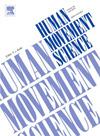Evidence of invariant lower-limb kinematics in anticipation of ground contact during drop-landing and drop-jumping
IF 1.9
3区 心理学
Q4 NEUROSCIENCES
引用次数: 0
Abstract
Gravity is a ubiquitous external force that must be considered when producing coordinated movements. Drop-landing is a popular task to study how humans cope with gravity, because anticipatory muscle activations can be released before the estimated ground contact. But the consequences of these anticipatory muscle activations have only been interpreted in terms of stiffening the lower-limbs in preparation for ground contact, without considering potential anticipatory kinematic consequences. The objective of this study is to quantify the kinematic consequences of anticipatory muscle activations in two different landing tasks, to clarify whether anticipatory muscle activations are adapted to cope with gravity, to the dynamic constraints of the movement to perform, or both.
Twenty young athletes performed drop-landing and drop-jumping from a 35 cm elevated platform. Sagittal angles and angular velocities of the hip, knee, and ankle joints, and acceleration of the foot were computed, as well as the onset of joint flexions and onset of foot vertical acceleration change.
We found the same pattern of anticipatory hip and knee flexion, both starting before ground contact in all participants and in both tasks. We found no anticipatory kinematics for the ankle joint. Consecutive to the hip and knee flexion, the foot accelerated upwards before ground contact.
Our results show that anticipatory muscle activations used by humans have systematic and invariant kinematic consequences during the air-time phase to cope with gravity: they initiate the hip and knee joints flexion before ground contact. This strategy likely limits the amount of ground reaction forces developed to oppose the gravity external force, and completes the stiffening role already described in the literature. These two complementary consequences —rotation and stiffening— seem to serve the same purpose of protecting the skeletal system. Since gravity is ubiquitous, these automated movements must be considered in other movements involving landing phases, such as heel strikes during gait.
落体着陆和落体跳跃过程中预期接触地面时下肢运动学不变的证据。
重力是一种无处不在的外力,在做出协调动作时必须加以考虑。在研究人类如何应对重力时,"落地 "是一项很受欢迎的任务,因为在预计的地面接触之前,可以释放预期的肌肉激活。但是,这些预知肌肉激活的后果只被解释为在准备接触地面时下肢变硬,而没有考虑潜在的预知运动学后果。本研究的目的是量化两种不同着地任务中预期性肌肉激活的运动学后果,以明确预期性肌肉激活是为了应对重力,还是为了适应动作的动态限制,或者两者兼而有之。20 名年轻运动员从 35 厘米高的平台上进行了落体着陆和落体跳跃。我们计算了髋关节、膝关节和踝关节的矢状角、角速度和脚的加速度,以及关节屈曲的开始时间和脚垂直加速度变化的开始时间。我们发现,在所有参与者和两项任务中,髋关节和膝关节的预期屈曲模式相同,都是在接触地面之前开始的。我们没有发现踝关节的预期运动学特征。在髋关节和膝关节屈曲的同时,脚在接触地面前向上加速。我们的研究结果表明,在空中时间阶段,人类使用的预测性肌肉激活具有系统性和不变性的运动学后果,以应对重力:它们在接触地面之前启动髋关节和膝关节屈曲。这一策略可能会限制为对抗重力外力而产生的地面反作用力的大小,并完成文献中已描述的僵化作用。这两个相辅相成的结果--旋转和硬化--似乎都是为了达到保护骨骼系统的目的。由于重力无处不在,在其他涉及着地阶段的运动中,如步态中的脚跟着地时,必须考虑这些自动运动。
本文章由计算机程序翻译,如有差异,请以英文原文为准。
求助全文
约1分钟内获得全文
求助全文
来源期刊

Human Movement Science
医学-神经科学
CiteScore
3.80
自引率
4.80%
发文量
89
审稿时长
42 days
期刊介绍:
Human Movement Science provides a medium for publishing disciplinary and multidisciplinary studies on human movement. It brings together psychological, biomechanical and neurophysiological research on the control, organization and learning of human movement, including the perceptual support of movement. The overarching goal of the journal is to publish articles that help advance theoretical understanding of the control and organization of human movement, as well as changes therein as a function of development, learning and rehabilitation. The nature of the research reported may vary from fundamental theoretical or empirical studies to more applied studies in the fields of, for example, sport, dance and rehabilitation with the proviso that all studies have a distinct theoretical bearing. Also, reviews and meta-studies advancing the understanding of human movement are welcome.
These aims and scope imply that purely descriptive studies are not acceptable, while methodological articles are only acceptable if the methodology in question opens up new vistas in understanding the control and organization of human movement. The same holds for articles on exercise physiology, which in general are not supported, unless they speak to the control and organization of human movement. In general, it is required that the theoretical message of articles published in Human Movement Science is, to a certain extent, innovative and not dismissible as just "more of the same."
 求助内容:
求助内容: 应助结果提醒方式:
应助结果提醒方式:


